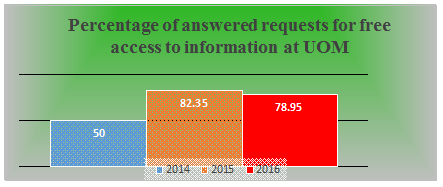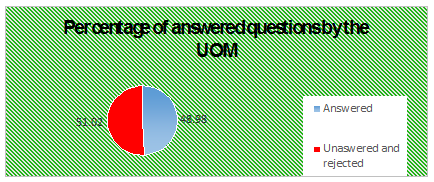Centre for Civic Education (CCE) reminds that transparency in the work of every institution is a precondition for the development of democratic society, while the access to information of public significance needs to be equally available for everyone. Being the oldest higher education institution in Montenegro, University of Montenegro (UoM) should be the leading one in the implementation of standards of transparency, because its current students will work in public institutions in near future. CCE regretfully notes the decrease of transparency in the work with UoM during past year, particularly during 2016.
Namely, the UoM management more frequently opts to hinder, restrict or sometimes even completely deny the access to information, which further disables the adequate monitoring of state of affairs and noting the problems at the UoM. Consequently, such relation of UoM raises suspicion in terms of the quality of ongoing process of reform at UoM.
CCE’s experiences indicates that the percentage of unanswered requests, submitted based on the Free Access to Information Law, rose by 3.4% in 2016, with a strong trend of ignoring those requests. In other words, the percentage decreased from 82.35% in 2015 to 78.95% in 2016. Moreover, during 2016, UoM responded on third of those requests only after CCE appealed to Agency for Free Access to Information. It is worth of mentioning that CCE, through the communication with UoM, continually indicated on the deficiencies of UoM’s site, which does convey a new creative expression and visual identity, but hides a lot of the information that used to be easily accessible at the UoM site, and by which the purpose of site itself is nowadays stultified.
This illustrates that UoM is returning to its old practices of non-transparency, since according to the CCE data, the percentage of unanswered requests in 2014 amounted 50%, after which it improved in 2015, only to decrease again in 2016.
This is supported with the fact that during 2016, UoM provided the answer for only 48.98% of the information if analysed based on the total number of answered questions, while 51.02% of other questions were left without an answer or they were directly rejected. It should be emphasised that the feedback to some of the questions was partial, that it did not provide an essential answer but an explanation used to disguise the insight into the existing state.
UoM’s alarming drop in the level of transparency is also illustrated by the fall of UoM at the Webometrics list of universities for 647 ranking places. Hence, UoM was ranked at 2997 place in 2016, as opposed to its 2350 in 2015, which annulled the short-lived increase from 2015. The extent to which the UoM is far from the universities of not just developed Western states, but of region as well, is best supported with the fact that, according to the same list, the University in Ljubljana is on 286 place (2711 places before the UoM), University of Zagreb is on 479 place (2518 places before UoM) and University in Belgrade is on 536 place (2461 places before UoM).
Once again, CCE calls the UoM management to demonstrate a higher level of responsibility in terms of the transparency of work at UOM, to proactively post more information of significance at the UoM site, as well as to consistently respect the Free Access to Information Law. We believe that it is in the interest of none in Montenegro for UoM to be so poorly ranked on relevant international lists, and that this situation could have been avoided had UoM been more open for the initiatives from Montenegro in this sense.
Mira Popović, programme associate


